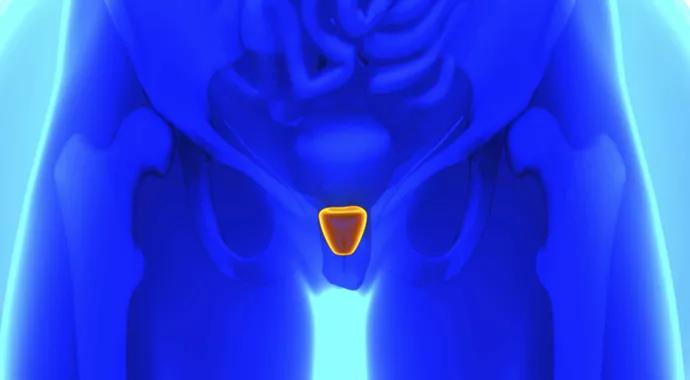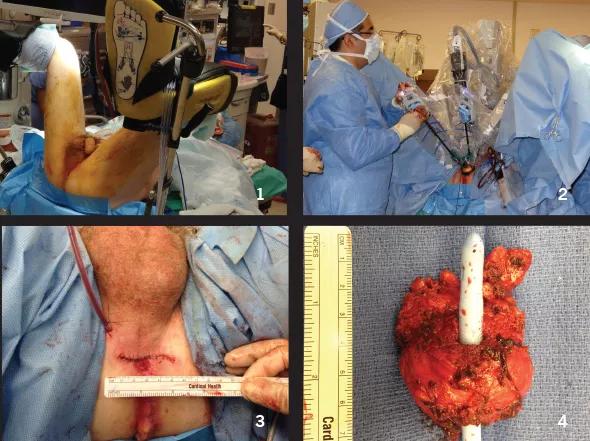Robotic radical perineal prostatectomy has potential advantages

By Jihad H. Kaouk, MD; Kenneth Angermeier, MD; and Oktay Akca, MD
Advertisement
Cleveland Clinic is a non-profit academic medical center. Advertising on our site helps support our mission. We do not endorse non-Cleveland Clinic products or services. Policy
At Cleveland Clinic’s Glickman Urological & Kidney Institute, we have explored the feasibility of robot-assisted radical perineal prostatectomy (RPP) with its inherent advantages of more direct access to the prostate and a small incision.
Since Young first described it in 1905, open RPP remained the most common surgical approach for the treatment of prostate cancer until the mid-1970s.
Urologists discontinued common performance of RPP due to concerns about the perineal anatomy; urologists are not generally familiar with the perineum since they routinely operate in the retropubic space and may be uncomfortable when operating close to the rectum. Additionally, the perineum is a deep and narrow space compared with the retropubic route.
Millin initially described the retropubic technique in 1945. Walsh et al. redefined the anatomical approach, applying the techniques of cavernous nerve sparing in the 1980s. For open surgery, the retropubic approach currently represents the preferred technique of most urologic surgeons based on habit rather than on evidence-based medicine.
Although the most widely used approach for open radical prostatectomy is the retropubic approach, there are no randomized studies demonstrating its superiority over the perineal approach in terms of cancer control and continence rates. Reported advantages of the perineal approach include shorter operative time and hospital stay, lower cost, and lower rates of postoperative urethral anastomosis stricture and inguinal hernia, owing to the lack of dissection and incision of the dorsal vascular complex, less blood loss and a lower rate of transfusion.
Advertisement
Robot-assisted laparoscopic radical prostatectomy (RALP) was first described in the early 2000s and currently represents the most commonly performed surgical approach for the treatment of prostate cancer in the United States. The increase in RALP can be attributed to its short learning curve and the advantage of its articulating design over laparoscopy.
We wondered whether similar advantages could exist when using the robot specifically for RPP, with the hypothesis that robotic instruments could overcome tricky points of open RPP, such as working in a deep and narrow surgical area.
We initially developed a cadaver model to examine the applicability of the da Vinci robotic surgical system for RPP. We completed all steps of the nerve-sparing radical prostatectomy operation using five cadavers.
After obtaining Institutional Review Board approval for robotic RPP, we selected for the first procedures those patients diagnosed with localized prostate cancer and a risk for lymph node positivity of not more than 4 percent.
The initial patient previously had undergone a total resection of his rectum to treat rectal cancer and had received pelvic radiotherapy. He was therefore living with an ileostomy. He also had mesh on the anterior abdominal wall owing to multiple hernia repairs.
Robotic RPP was completed successfully without complications, with an estimated blood loss of 50 cc. The patient was discharged on postoperative day one and was immediately continent when his urethral catheter was removed one week after surgery (Figures 1-4).
Advertisement

Figure 1. Exaggerated lithotomy position. Figure 2. Robot docking, approaching from head and passing between legs. Figure 3. Incision closure. Figure 4. Robotic RPP specimen.
The potential technical advantages of robotic RPP over open RPP include the magnified view as well as the long, articulated robotic instruments, which may help minimize the difficulty of performing a procedure in such a narrow and deep surgical field.
In our initial patient, we were able to complete the procedure with an incision just large enough (4 cm) for specimen extraction. Minimizing the incision could also decrease postoperative pain and analgesia requirements.
In comparing robotic RPP with standard RALP, a perineal approach provides more direct access to the prostate than does the anterior abdominal wall, which allows for elimination of the first three steps commonly done in RALP (bladder mobilization, endopelvic fascia incision and dorsal vein complex dissection). Elimination of these steps could result in shorter operative time and less blood loss.
Robotic RPP eliminates risks of injury to abdominal organs and vessels, given its extraperitoneal nature. It might also be useful in those patients who have undergone a previous abdominal operation, similar to our initial patient and those who are severely obese.
In conclusion, the intersection of the da Vinci robotic surgical system and a natural anatomic approach to radical perineal prostatectomy might provide a new minimally invasive solution for patients diagnosed with localized prostate cancer.
Advertisement
Dr. Kaouk is Director of Cleveland Clinic Glickman Urological & Kidney Institute’s Center for Robotic and Laparoscopic Surgery and is the Urological & Kidney Institute’s Vice Chair for Surgical Innovations. He is Professor of Surgery at Cleveland Clinic Lerner College of Medicine.
Dr. Angermeier is a staff member of Cleveland Clinic Glickman Urological & Kidney Institute’s Department of Urology and Director of the Center for Genitourinary Reconstruction.
Dr. Akca is a research fellow in the Department of Urology.
Advertisement
Advertisement

First-of-its-kind research investigates the viability of standard screening to reduce the burden of late-stage cancer diagnoses

Global R&D efforts expanding first-line and relapse therapy options for patients

Study demonstrates ability to reduce patients’ reliance on phlebotomies to stabilize hematocrit levels

A case study on the value of access to novel therapies through clinical trials

Findings highlight an association between obesity and an increased incidence of moderate-severe disease

Cleveland Clinic Cancer Institute takes multi-faceted approach to increasing clinical trial access 23456

Key learnings from DESTINY trials

Overall survival in patients treated since 2008 is nearly 20% higher than in earlier patients